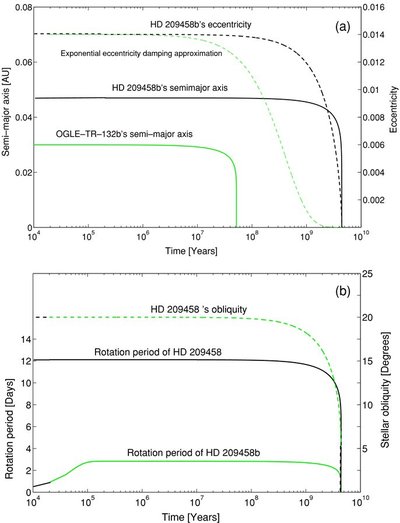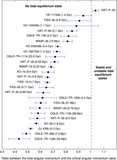Image Details

Caption: Figure 2.
Long-term integrations of orbital and rotational parameters of some transiting planets and their host star. Tidal quality
parameters
Q′
![]() and
Q′
p
are initially set to 10
6 but vary with the semimajor axis as
Q
and
Q′
p
are initially set to 10
6 but vary with the semimajor axis as
Q
![]() =
Q
p
= 1/(
nΔ
t) where Δ
t is a constant tidal time lag. (a) Semimajor axis of OGLE-TR-132b, HD 209458b (solid lines), and eccentricity of HD 209458b
(dashed line) as a function of time. The thin dashed line is the usual exponential damping approximation of
e with a 4.1 × 10
8 yr relaxation time assuming that only tides raised on the planet are considered and stable tidal equilibrium states exist;
(b) rotational periods of HD 209458, HD 209458b (solid lines), and HD 209458's obliquity (dashed line) as a function of time.
The initial rotational period of HD 209458b and HD 209458 stellar obliquity are arbitrarily set to half a day and 20° to evaluate
the respective timescales of their tidal evolution.
=
Q
p
= 1/(
nΔ
t) where Δ
t is a constant tidal time lag. (a) Semimajor axis of OGLE-TR-132b, HD 209458b (solid lines), and eccentricity of HD 209458b
(dashed line) as a function of time. The thin dashed line is the usual exponential damping approximation of
e with a 4.1 × 10
8 yr relaxation time assuming that only tides raised on the planet are considered and stable tidal equilibrium states exist;
(b) rotational periods of HD 209458, HD 209458b (solid lines), and HD 209458's obliquity (dashed line) as a function of time.
The initial rotational period of HD 209458b and HD 209458 stellar obliquity are arbitrarily set to half a day and 20° to evaluate
the respective timescales of their tidal evolution.
Copyright and Terms & Conditions
© 2009. The American Astronomical Society. All rights reserved.




